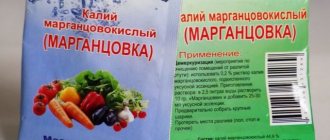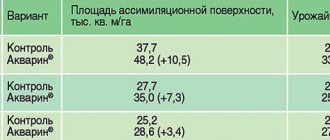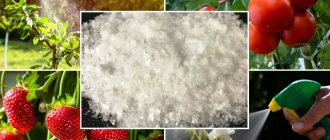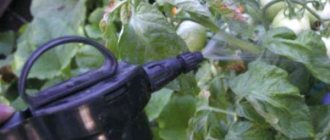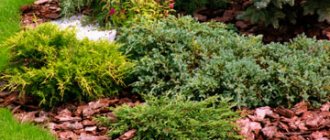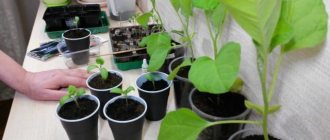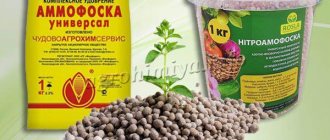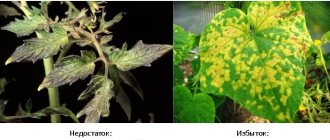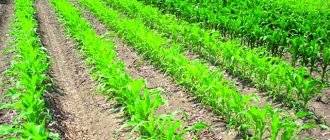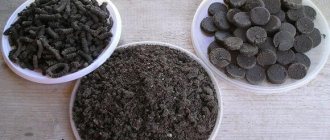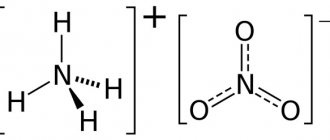Nitroammofosk: description and composition of fertilizer
When dry, the substance is peach, pink or light brown granules. The chemical formula of the drug is NH4H2PO4+NH4NO3+KCL, from which it can be seen that the nitroammofosk fertilizer contains:
- phosphorus (16-24%);
- nitrogen (8-17%);
- potassium (16-24%).
Each of the components is important for plants at different stages of life:
- nitrogen promotes the active development of leaf mass, optimizes photosynthesis and metabolic processes in cells;
- phosphorus has a beneficial effect on the formation of new cells and the development of the root system;
- potassium promotes flowering and ovary formation, crops become resistant to diseases.
Based on its main components, fertilizer is abbreviated as NPK. The effectiveness of the drug is explained by the fact that almost all elements are in an easily digestible form.
The agrochemical is soluble in water, non-toxic and non-explosive, and has a weak oxidizing property.
Types of nitroammophoska
The fertilizer is available for sale in several types, which differ in the concentration of active chemical components. This allows you to select an additive that is optimally suited for a specific soil. The main values are presented in the table below.
| NPK concentration proportions | On what soil is it effective? | For which crops is it suitable? |
| 16:16:16 (1:1:1) | Any | All |
| 8:24:24, 15:15:20 and 13:13:24 | With a lack of potassium and phosphorus (chernozems and sierozems) | Potatoes, legumes, wheat, beets |
| 21:0,1:21 and 17:0,1:28 | Rich in phosphorus | Rapeseed, fodder crops, sugar beet, sunflower |
Nitroammofoska: purpose of the drug
Nitroammophoska can be used when working with different types of soils. Thus, with its help, various types of vegetables, berry bushes, as well as flowers and fruit trees are fertilized.
This fertilizer includes all those elements that are necessary for the development of cultivated crops.
Forms of release of the drug
Fertilizer is produced in the form of granules. And all the contained elements necessary for nutrition are in a form that is easily accessible to plants.
Compound
One of the main advantages of this drug is the presence of a high concentration of nitrogen, which is extremely useful for any crops. As for phosphorus, this element is found in three forms: calcium dihydrogen phosphate (Ca(H2PO4)2), calcium hydrogen phosphate (CaHPO4 2H2O), and ammonium phosphate (CaNH4PO4).
Due to its special properties, the substance Ca(H2PO4)2 is able to dissolve well in HNO3, in other words, in nitric acid. Thanks to this, phosphorus is quickly released from its original state and passes into a form more favorable for plant nutrition. It is this process that explains the speed of action of nitroammophoska.
Operating principle
The substances that make up nitroammophoska are compounds with pronounced fire and even explosive properties.
All substances included in the fertilizer are extremely necessary at different stages of plant growth:
- nitrogen stimulates faster growth and development of leaves, improves metabolic processes in plant cells;
- phosphorus promotes normal root growth and has a positive effect on the appearance of new cells;
- thanks to potassium, the flowering process is accelerated, and plant resistance to harmful factors, including diseases, increases.
The fertilizer also has another name - NPK, which comes from the abbreviation of the names of the substances included in the composition. The most important reason for the effectiveness of nitroammophoska is that all its components are easily available for absorption by plants.
This chemical is water-soluble, non-toxic, and also has mild oxidizing properties.
Advantages of the drug
This mineral fertilizer, like any other, has its pros and cons. This is a very effective substance, but it can often manifest itself as an aggressive compound that requires careful handling when handling. But, in spite of everything, nitroammofoska has such activity and a positive effect on the development and growth of plants that ultimately gardeners ignore its few shortcomings.
Advantages:
- there is no sticking of granules to each other during long-term storage. The basic properties and friability are maintained throughout the specified warranty period;
- the fertilizer contains a very high concentration of useful substances. Their share is more than 30% of the total mass of the substance;
- much less fixed by the soil, in contrast to one-component options;
- all of the above chemical elements, namely nitrogen, phosphorus and potassium, are located inside one granule;
- good solubility in water is noted;
- an increase in the total amount of harvest obtained by 35%-70% is recorded. However, it should be borne in mind that for each culture the meaning is individual.
Disadvantages of use
Flaws:
- comes from inorganic matter;
- due to the use of the chemical, nitrates are deposited in the soil;
- is a substance dangerous to humans (third level of danger). Capable of ignition and explosion;
- relatively short shelf life.
Features of using nitroammophoska in the garden
The total content of useful substances in the fertilizer is 50%. Nitrogen is in nitrate and ammonium forms, phosphorus is in the form of ions, potassium is in the composition of hydrochloric acid salts. Thanks to this feature, the additive is perfectly absorbed by the plant. At the dacha there are various ways to use the drug:
- application to the soil before sowing in dry form;
- watering with an aqueous solution;
- foliar feeding.
To prevent the accumulation of nitrates in fruits, fertilizing should be stopped well before harvest.
Compatibility with other drugs
The agrochemical can be used in conjunction with fungicides. Use in conjunction with granulated phosphorus-containing or potassium fertilizers (ammonium sulfate, ammonium nitrate, superphosphate, ammophos, diammophos, potassium chloride) is allowed.
Nitroammofoska cannot be mixed with ash and fluff, manure and litter, as well as with other nitrogen-containing and powdered or crystalline phosphorus-potassium mineral fertilizers (various phosphates, karboammofos, karboammofoska, potassium sulfate).
What to fertilize with nitroammophoska?
Nitroammophoska for tomatoes
Nitroammophoska is often used as the main fertilizer for tomatoes. This is primarily due to the fact that tomatoes are susceptible to the following diseases: mosaic, brown spot, blossom end and bark rot, Alternaria blight, late blight and scab.
It is recommended to apply fertilizer no more than twice per season. Initially, you should use the 16:16:16 brand of fertilizer. Subsequent fertilizing must be done before the first fruit sets.
To ensure that your tomato fruits have a sweetish taste, you should use brands of nitroammophoska with an increased potassium content. It is potassium that contributes to the formation of plant sugars.
Nitroammofoska for strawberries
It is necessary to feed strawberries in early spring with the appearance of the first shoots. Do not forget that the brand of nitroammophoska is determined primarily by the characteristics of the soil on which the fertilizer will be used. The age of the strawberry bushes themselves also plays a big role.
- As soon as the bushes are planted, the soil should be fed with fertilizer. The standard use is about two tablespoons per square meter.
- If the strawberries are more than two years old, then fertilizing with nitroammophos requires more careful preparation. To do this, you will need to dilute one tablespoon of the drug in a 10-liter container. In this case, the resulting solution must be added to the soil immediately after harvesting the fruits.
- If the strawberries are three or more years old, you need to make the following solution: dilute two tablespoons of the drug in a 10-liter container. In this case, each bush will require approximately half a liter of solution. The plant is treated with the resulting solution before budding begins.
For potatoes
Potatoes belong to the tuber crops, which require a trace element such as potassium for the growth and formation of healthy tubers. That is why experienced agronomists use nitroammofoska as the main fertilizer for potatoes.
When planting potato tubers, nitroammophoska is added to the ground in both liquid and dry form. In the second case, approximately 20 grams of granules are placed in each well.
For grapes
The grapes mainly grow in southern regions with warm climates. Cultivating vineyards in regions with more severe climatic conditions is also possible, but requires certain additional actions, such as saturating the soil with mineral fertilizers. Nitroammofoska is used both for root feeding and for treating the crown of the plant.
Fertilizer application rates for different plants
Nitroammofoska as a fertilizer has instructions for use, which should be studied in detail before use. Doses of nutritional supplements depend on the crop, type of soil and feeding method. Violation of these standards negatively affects the health of the plant and the quality of the crop.
Use in the garden
The use of nitroammophoska has a beneficial effect on the quantitative and qualitative indicators of vegetable yield: the components of the fertilizer help optimize all biochemical processes in plant cells, due to which growth accelerates, the number of ovaries increases, and fruits accumulate starch and sugar. The drug makes plantings resistant to common diseases. Adding nitroammophoska to the soil repels the mole cricket.
A fertilizer with the same content of active components is suitable for various types of soils, especially effective on chernozem and sierozem soils. It is better to fertilize heavy substrates with a granular substance.
Typically, nitroammophoska is applied in the spring when digging beds for all vegetables, on average 40 g per square, and for untreated soil - 50 g. In the future, the plants should be watered or sprayed with an aqueous solution (2 tablespoons diluted in a bucket of water). You need to feed in the evening or in cloudy weather. After feeding, abundant irrigation with clean water is required. For field crops, the norms are as follows (kg / 1 ha):
- sugar beets – 150;
- corn – 200;
- oats, rye and barley – from 100 to 150;
- wheat - from 150 to 200 kg.
Nitroammofoska is very effective for tomatoes, as it makes them less vulnerable to late blight and scab; Fruit ripening increases and taste improves. Tomatoes are treated with the drug several times:
- 2 weeks after spring transplantation, fertilize unprotected beds with a solution of 1 tablespoon of the drug and a bucket of water, consumption - half a liter per bush.
- After 30 days, this feeding is repeated again.
- During the flowering period, it is advisable to spray with a liquid composition: take a tablespoon of nitroammophosphate and sodium humate and dilute it in 10 liters of water.
In order for potato bushes to grow faster and the root system to become strong and developed, this tuber can be fertilized by adding 20 g per square to the holes when planting or watering it with an aqueous solution at the rate of 3 kg of granules per hundred square meters.
Nitroammophoska for cucumbers is productive: it helps to increase the number of ovaries, extends the fruiting period and improves the taste. You need to feed the bushes twice:
- When preparing a bed for planting, add 30 g of the substance per 1 m².
- At the beginning of flowering, before the ovaries appear, use a watering solution of 2 tablespoons of the drug and a bucket of water, spending 0.3-0.5 liters for each plant.
When growing vegetable crops, nitroammophoska is used for seedlings. The fertilizer stimulates growth well and satisfies the seedlings' need for essential nutrients. Fertilizing is carried out 12-14 days after placing the sprouts in separate cups. Half a tablespoon is dissolved in 5 liters of water, 100 ml of the composition is poured under each plant. After 2 weeks, this procedure is repeated.
Application in the garden
Nitroammofoska is used for various fertilizing in the garden: it is applied to the holes during planting, fertilized by the root method and sprayed.
Strawberries and wild strawberries are fed in bulk on top of the soil at a rate of 40 g/m².
Berry bushes are fed as follows:
- When planting young raspberries, 50 g of the substance is added to the hole, and then every year at the end of flowering, spraying is carried out with a solution of 40 g of granules and 10 liters of water, using a bucket for each square.
- Currants and gooseberries are fertilized by scattering a dry preparation of 70 g per bush under each plant.
For fruit trees, fertilizing is used as follows:
- When planting a seedling, 400 g of granules are added to the bottom of the hole.
- Every year, when the tree has flowered, root feeding is done with a liquid composition (50 g of agrochemical dissolved in 10 liters of water). Water the ground in a circle near the trunk, 30-50 liters for each tree.
The use of nitroammophoska for grapes has a good effect. For active growth, add 25 g per square under the root, and also spray with an aqueous solution of 2 tablespoons of the drug per bucket of water.
The rose can be fertilized in the spring after removing the cover and in the fall in preparation for wintering. To do this, prepare a composition of 2 tablespoons of granules and 10 liters of water, water each rose bush to a depth of no more than 4 cm. Other flower annuals and perennials can be fed with the same solution 2 weeks after emergence, during budding and during the period of active flowering .
Application for indoor flowers
Indoor plants also need additional nutrition. The use of nitroammophoska activates growth and increases the number of buds in flowering crops. The flower should be sprayed in the spring with a liquid composition of 3 tablespoons of granules diluted in a 10-liter bucket.
Where can the drug be used?
This fertilizer is universal, as it can be used on all types of soil and for almost all garden and vegetable crops, as well as seedlings. The fertilizer is effective and allows you to accelerate the growth and development of plants, promotes the abundant appearance of ovaries, improves the taste of fruits and accelerates their ripening.
Nitroammophoska can be used as a fertilizer for the following crops:
- beets;
- potatoes;
- tomatoes;
- cucumbers;
- grapes;
- berry bushes;
- fruit trees;
- garden and indoor flowers.
This fertilizer is a gray granular substance. The usual packaging of fertilizer is in bags of 1 and 3 kg.
Advantages and disadvantages of nitroammophoska
Before using fertilizer on your site, you should consider all aspects of the agrochemical. The positive qualities of the drug include the following:
- high concentration of active elements in a form convenient for absorption by plants;
- granules are soluble in water;
- does not cake when stored correctly;
- every grain of the substance contains nitrogen, phosphorus and potassium;
- application allows increasing productivity by 30-70%.
Despite a lot of advantages, nitroammophoska has disadvantages:
- may lead to the accumulation of nitrates in fruits;
- can be stored for only six months;
- has a tendency to ignite.
Nitroammophoska: application. How to work with the substance correctly
There are several recommendations.
First recommendation. It has already been said before that chemicals are dangerous to humans, nitroammophoska has explosive properties, and heating the chemical is prohibited. The best place to store the chemical is a cool room made of stone or concrete; the temperature inside should not exceed thirty degrees.
Second recommendation. It is best to keep the humidity below fifty percent. To avoid various reactions with other fertilizers, nitroammophos should be stored separately. Uncontrolled reaction may result in fire or explosion. You cannot use fire or lighters in the room where the fertilizer is stored.
Third recommendation. Nitroammophoska can be stored for only one hundred and eighty days. Over time, the properties of the fertilizer are lost and it becomes useless, but the risk of explosion increases.
Fourth recommendation. Fertilizers of any type can only be transported by land.
Fertilizer analogues
Among the mineral complexes, in addition to nitroammophoska, there are many preparations with a similar composition. Azofoska
This is the closest drug in content, which contains sulfur in addition to nitrogen, potassium and phosphorus. The proportions of the concentration of active elements depend on the manufacturer and brand of fertilizer. Azofoska has the same effect on plant crops as nitroammophoska. Both substances are interchangeable.
Ammofoska
This agrochemical also belongs to the class of NPK complexes, but differs in the content of sulfur (from 14%) and magnesium, ballast components are in minimal quantities. Ammofoska, unlike its “relatives”, is applicable in greenhouses and greenhouses.
Nitrophoska
In addition to the main 3 elements, the composition of the substance is supplemented with magnesium. The additive is less effective. Nitrogen is contained only in nitrate form, so it is quickly washed out and affects the plant for a short period of time.
Nitroammophoska, in addition to the nitrate ion, also has an ammonium ion, which lingers in the soil and has a long-term effect.
Nitroammophos
Another name for fat is nitrophosphate. It consists of 2 active ingredients and does not contain potassium. The scope of use of such a drug is limited due to low effectiveness.
How can I replace Nitroammofoska?
On store shelves you can find fertilizers Ammofoska, Nitrophoska, Nitroammophos. In fact, these are the same drugs with different ratios of active elements in them.
Ammofoska
This 3-element concentrated fertilizer contains 14% sulfur and magnesium.
The composition does not include chlorine and sodium; there is a minimum amount of neutral impurities.
The drug is easily soluble in water and therefore safe for use in greenhouses. Effective use on sandy and clay soils.
Nitrophoska
The complex fertilizer has the same composition as Nitroammofoska, but is enriched with magnesium.
The drug contains ammonium nitrate and concentrated phosphorus, ammonium phosphate and potassium chloride. Nitrogen is contained in the form of nitrates, so it is quickly washed out of the soil.
Fertilizer can also be used at the time of flowering of crops.
Nitroammophos
Includes equal amounts of phosphorus and nitrogen, balanced additions of ammonium nitrate and phosphate.
Easily soluble in water and used for fertilizing agricultural land.
Storage conditions and shelf life
The substance should be stored in a separate room at a temperature not exceeding 30 °C. Staying near open flames or heating devices is prohibited. In sealed packaging, the granules do not cake. Due to the high solubility of the chemical, it must be protected from water penetration.
In unopened packaging, the fertilizer is stored for 18 months, if opened – for six months.
After the expiration date, the drug loses its properties and can cause a fire.
Nitroammophoska: harm to humans
The fertilizer belongs to hazard class III due to the substance’s ability to cause a fire if stored improperly. The content of nitrates in the composition frightens the possibility of their accumulation in vegetables and fruits, which are harmful to health. This is possible if the rules of use are not followed.
To prevent nitrates from accumulating in fruits, fertilizing with the drug should be stopped 2-3 weeks before harvest. Exceeding the permissible standards will provoke inhibition of biochemical processes inside the plant.
Microelements for strawberries
Boron, magnesium, iron, copper, manganese, zinc are involved in all processes, and their presence in the soil has a positive effect on the plant. For example, manganese enhances cold resistance. Copper helps in resisting fungal infections. Boron promotes the formation of ovaries.
Boron does not pass from old, dying leaves to young ones and is required throughout the entire growing season of the plant. To use boric acid correctly, it is necessary to take into account the boron needs of garden crops. Although strawberries belong to the group of crops least dependent on the amount of boron, the lack of this element seriously affects them.
Signs of boron deficiency in garden strawberries: curvature of leaves and necrosis of the edges. Fertilizing with boric acid significantly increases the yield and improves the taste of the berries. In early spring, plantings are watered with a solution of boric acid with the addition of potassium permanganate (1 g potassium permanganate, 1 g boric acid per 10 liters of water), consumption - approximately 10 liters per 30-40 bushes. It is useful to carry out foliar feeding with a solution of boric acid (5 g per 10 liters of water).
Before flowering, at the stage of bud formation, apply foliar fertilizing with a boron solution (2 g boric acid, 2 g manganese, 1 glass of sifted ash per 10 liters of water). Make an extract from the ash in advance: pour a glass of ash with a liter of boiling water and leave, stirring occasionally, for a day, then filter through cheesecloth - and the infusion is ready.
Adding ash to strawberries
Basic precautions for use
Despite the fact that nitroammophoska is not a toxic agricultural product, its physical and chemical properties require compliance with certain rules when working:
- Do not allow the substance to heat up; contact with direct sunlight and heat sources should be avoided.
- The chemical should be stored indoors made of non-flammable materials. It is better to place the fertilizer on a metal or ceramic substrate separately from other additives.
- Limit access of animals and children to agrochemicals.
- Use the drug according to the instructions, following the rules and dosage for each crop.
- It is not recommended to use the substance after the expiration date.
- During work, you need to use rubber gloves and a respirator, avoid getting the drug on your skin, eyes and mouth. If signs of poisoning appear, seek medical help immediately.
Nitroammofoska has been used in agriculture for more than 40 years, during which time it has established itself as an effective long-acting complex fertilizer. The versatility of the composition allows the agrochemical to be used on any soil for almost all crops and achieve excellent results. Potential harm is possible only in cases of improper use.
Instructions for use
Like any other fertilizer, nitroammofosk has specific instructions that determine the method of application. It must be studied in detail before use.
It is worth noting that the dosage of this additive depends on many factors, such as: the nature of the crop itself, the type of soil, and the method of feeding. If the above rules are violated, the use of the drug may adversely affect the quality of growth and development of the crop.
General recommendations
If this fertilizer is used frequently, there may be a risk that nitrates will be deposited in the vegetables being grown. It is known that traces of chemical compounds can remain in plant structures if fertilizer is used until the fruits begin to appear and ripen.
For this reason, it is necessary to monitor the fertilizing process and stop introducing the substance into the soil in time. It is known that nitrates are also found in organic compounds. Therefore, with frequent use there is a risk of harming the plants.
Precautions for use
As mentioned above, this fertilizer is classified as a third hazard class due to the fact that the substances it contains can cause a fire if used and stored incorrectly. The fact that nitrates are found in the composition is often frightening because they can accumulate in the soil, and then in grown crops. This is indeed possible if the fertilizer is used incorrectly.
In order to avoid the accumulation of nitrates in fruits, it is necessary to stop fertilizing three weeks before the start of harvest. If the permissible dosage is exceeded, normal processes in plant cells may be disrupted.
List of precautions when working with fertilizer:
- Avoid heating the substance. To do this, you should prevent its contact with any sources of heat and sunlight.
- Fertilizer must be stored exclusively in rooms that consist of non-combustible materials. The best option is storage on metal or ceramic substrates.
- It is important to prevent animals from accessing the fertilizer.
- It is necessary to carefully follow all dosage rules and instructions in general.
- After the expiration date, use of the drug is highly not recommended.
- To work with fertilizer, you will need rubber gloves and a respirator. Do not allow the substance to come into contact with the skin, eyes, mouth or mucous membranes. If you notice symptoms of poisoning, you should immediately consult a doctor for help.
How to breed
When carrying out foliar feeding, it is necessary to dilute the fertilizer at the rate of one tablespoon of granules per 10 liters of water. Thus, the required concentration of the substance is obtained.
Fertilizing by spraying may be suitable for vegetables and fruit trees.
